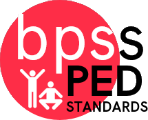BPS Physical Education Standards Book
PE Grade Levels
Grade 03
Young children arrive in 3rd Grade with widely varying knowledge in ....
3rd Grade Physical Education "I can ... statements"
PED-03.S1 Student demonstrates competency in a variety of motor skills and movement patterns.
- Locomotor Cluster:
- PED-03.S1.01: Leaps using a mature pattern.
- PED-03.S1.02: Travels showing differentiation between sprinting and running.
- PED-03.S1.03: Jumps and lands in the horizontal plane using a mature pattern.
- PED-03.S1.04: Jumps and lands in the vertical plane using a mature pattern.
- PED-03.S1.05: Performs teacherselected and developmentally appropriate rhythmic activities/dance steps and movement patterns.
- PED-03.S1.06: Performs a sequence of locomotor skills, transitioning from one skill to another smoothly and without hesitation (e.g., hop, skip, jump forward/backward).
- Non Locomotor (stability) Cluster:
- PED-03.S1.07: Transfers weight from feet to hands for momentary weight support.
- PED-03.S1.08: Applies skill.
- PED-03.S1.09: Applies skill.
- PED-03.S1.10: Moves into and out of gymnastics balances with curling, twisting and stretching actions.
- PED-03.S1.11: Combines locomotor skills and movement concepts (e.g., levels, shapes, extensions, pathways, force, time, flow) to create and perform dance/rhythmic movement.
- PED-03.S1.12: Combines balance and weight transfers with movement concepts to create and perform dance/rhythmic movement.
- Manipulative Cluster:
- PED-03.S1.13: Throws underhand to a partner or target with reasonable accuracy
- PED-03.S1.14: Throws overhand, demonstrating three of the five critical elements of a mature pattern, in nondynamic environments (closed skills), for distance and/or force.
- PED-03.S1.16: Catches a gently tossed hand-sized ball from a partner, demonstrating four of the five critical elements of a mature pattern.
- PED-03.S1.17: Dribbles and travels in general space at slow to moderate jogging speed with control of ball and body.
- PED-03.S1.18: Dribbles with the feet in general space at slow to moderate jogging speed with control of ball and body. (
- PED-03.S1.19: Passes and receives a ball with the inside of the foot to a stationary partner, givin on reception before returning the pass
- PED-03.S1.21a: Uses a continuous running approach and intentionally performs a kick along the ground and a kick in the air, demonstrating four of the five critical elements of a mature pattern for each.
- PED-03.S1.21b: Uses a continuous running approach and kicks a stationary ball for accuracy.
- PED-03.S1.22: Volleys an object with an underhand or sidearm striking pattern, sending it forward over a net, to the wall or over a line to a partner, while demonstrating four of the five critical elements of a mature pattern. (
- PED-03.S1.24a: Strikes an object with a short-handled implement, sending it forward over a low net or to a wall.
- PED-03.S1.24b: Strikes an object with a short-handled implement while demonstrating three of the five critical elements of a mature pattern.
- PED-03.S1.25: Strikes a ball with a long-handled implement, sending it forward, while using proper grip for the implement (e.g., hockey stick, bat, golf club). Note: Use batting tee or ball tossed by teacher for batting.
- PED-03.S1.27: Performs intermediate jump-rope skills (e.g., a variety of tricks, running in and out of long rope) for both long and short ropes.
PED-03.S2 Applies knowledge of concepts, principles, strategies and tactics related to movement and performance.
-
- PED-03.S2.01: Recognizes the concept of open spaces in a movement context
- PED-03.S2.02: Recognizes locomotor skills specific to a wide variety of physical activities.
- PED-03.S2.03: Combines movement concepts (direction, levels, force, time) with skills as directed by the teacher.
- PED-03.S2.04a: Employs the concept of alignment in gymnastics and dance.
- PED-03.S2.04b: Employs the concept of muscular tension with balance in gymnastics and dance.
- PED-03.S2.05a: Applies simple strategies and tactics in chasing activities.
- PED-03.S2.05b: Applies simple strategies in fleeing activities.
PED-03.S3 Demonstrates the knowledge and skills to achieve and maintain a health-enhancing level of physical activity and fitness.
-
- PED-03.S3.01a: Charts participation in physical activities outside physical education class (e.g., indoor and outdoor recess).
- PED-03.S3.01b: Identifies physical activity benefits as a way to become healthier.
- PED-03.S3.02: Engages in the activities of physical education class without teacher prompting.
- PED-03.S3.03: Describes the concept of fitness and provides examples of physical activity to enhance fitness.
- PED-03.S3.04: Recognizes the importance of warmup & cool-down relative to vigorous physical activity.
- PED-03.S3.05: Demonstrates, with teacher direction, the health-related fitness components.
- PED-03.S3.06: Identifies foods that are beneficial for before and after physical activity.
PED-03.S4 Exhibits responsible personal and social behavior that respects self and others.
-
- PED-03.S4.01: Exhibits personal responsibility in teacher-directed activities.
- PED-03.S4.02: Works independently for extended periods of time.
- PED-03.S4.03: Accepts and implements specific corrective teacher feedback.
- PED-03.S4.04a: Works cooperatively with others.
- PED-03.S4.04b: Recognizes others for their success/effort in movement performance.
- PED-03.S4.05: Recognizes the role of rules and etiquette in physical activity with peers.
- PED-03.S4.06: Works independently and safely in physical activity settings.
PED-03.S5 Recognizes the value of physical activity for health, enjoyment, challenge, self-expression and/or social interaction.
-
- PED-03.S5.01: Discusses the relationship between physical activity and good health.
- PED-03.S5.02: Discusses the challenge that comes from learning a new physical activity.
- PED-03.S5.03: Reflects on the reasons for enjoying selected physical activities.
- PED-03.S5.04: Describes the positive social interactions that come when engaged with others in physical activity.
